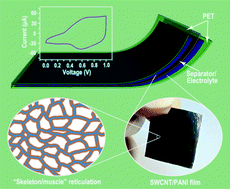Scientists in China, Singapore and Australia have made a supercapacitor electrode from a single-walled carbon nanotube (SWCNT) skeleton surrounded by a polyaniline (PANI) skin. This hybrid film was made by in situ electrochemical polymerisation in which a directly grown SWCNT film with continuous reticulate architecture acts as a skeleton and PANI is electrodeposited as a ‘skin’.
The unique reticulate structure of the SWCNT film has an advantage in transporting electrons over a larger area, and the continuous SWCNT/PANI structure avoids the PANI/PANI overlaps seen in other composites, which reduce power density. Previous SWCNT/PANI composite electrodes have been brittle, which hinders their practical application; the films produced here display good mechanical properties, thinness and porosity, making them more applicable in flexible energy storage devices. In addition to this, high energy and power densities were achieved (131 Wh/kg and 62.5 kW/kg, respectively) – this is compared to other CNT/PANI-based supercapacitors (<2.5 kW/kg).
Read this exciting Energy & Environmental Science article today:
A “skeleton/skin” strategy for preparing ultrathin free-standing single-walled carbon nanotube/polyaniline films for high performance supercapacitor electrodes
Zhiqiang Niu, Pingshan Luan, Qi Shao, Haibo Dong, Jinzhu Li, Jun Chen, Duan Zhao, Le Cai, Weiya Zhou, Xiaodong Chen and Sishen Xie
Energy Environ. Sci., 2012, 5, 8726-8733
DOI: 10.1039/C2EE22042C











